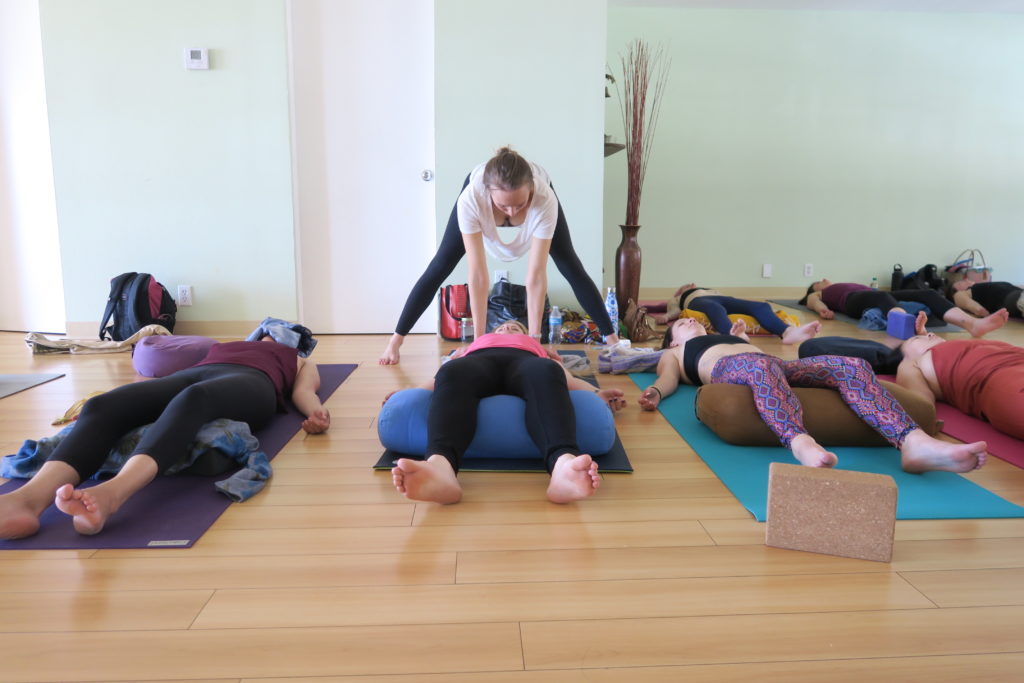Since emerging into the Western world, yoga has grown and evolved immensely through different styles and variations. The ancient Eastern system is now a Universal one that yogis practice, teach, and preach all over the world.
Old, young, weak, and strong – there’s a reason why so many different people turn to yoga.
Whether it’s a powerful, sweaty workout, a nice deep stretch, 20 minutes resting in child’s pose, or minute by minute tuning into the breath.
With so many different ways to practice, yoga is all about finding the right style for you.
You can choose from active yoga styles like Ashtanga, Vinyasa Flow, and Acro Yoga or slow things down with a more passive practice of yin or restorative yoga, or a healing Yoga Nidra class.
Recommended Reading: Levels of Yoga Certification: What The Heck Is The Difference Between 200-, 300-, and 500-Hour YTT Courses?
What Is Yoga Nidra?

Originating from ancient yogic scriptures, Yoga Nidra is a powerful relaxation technique that uses guided imagery with the natural process of sleep to enter a regenerative state of consciousness between being awake and sleeping.
Yoga Nidra is also known as yogic sleep or iRest meditation.
The deeply therapeutic exercise is a methodical practice of directed steps, focused on moving awareness from the external world into the internal world.
Stimulating complete physical, mental, and emotional relaxation, the healing practice of Yoga Nidra has countless documented benefits.
Nidra practices can:
- Promote deep relaxation
- Aid insomnia
- Alleviate tension
- Restore the body
- Sharpen the mind
- Improve memory
- Reduce symptoms of stress, anxiety, and depression
Unlike typical meditation, Yoga Nidra is practiced lying down. You support the body with props, pillows, and blankets so that you can land in a space of deep relaxation and rest.
While ‘yogic sleep’ is not a substitute for your regular night’s sleep, many people say one-hour of Yoga Nidra meditation is equal to 4 hours of normal sleep in its restorative effects on the nervous system.
Yoga Nidra practice triggers a sequence of brain-wave changes that alter the fluctuations of the mind and shift the brain into a state of healing and restoration.
The process lets go of stress-producing hormones and boosts the production of neurotransmitters and pleasure hormones like serotonin, dopamine, endorphins, and others.
The end result? A massively positive effect on overall human well-being.
Where To Get Your Yoga Nidra Certification
Holding a Yoga Nidra certification presents countless benefits whether you’re just getting started on your yoga teaching journey or you’ve been guiding students for 10+ years.
Heck, even if it’s solely to deepen your personal practice, a Yoga Nidra certification is a great thing to add to your knowledge base.
There’s so much goodness to soak up. For yourself and for others.
You can find Yoga Nidra training anywhere from India’s Himalayan mountains to beachside in the tropics, or your favorite community yoga studio.
These days, you can even find high-quality Yoga Nidra trainings offered online.
If you’re looking for a gentle introduction to Yoga Nidra or want a clear understanding of the essentials, you can attend a Yoga Nidra workshop or choose from a selection of Yoga Alliance continuing education courses that range between 20 to 60 hours of contact and non-contact training.
You Might Also Like: What is Yoga Alliance and Do I Need an RYT Certificate to Teach Yoga?
If it’s a more in-depth study you seek, you’ll find 100-hour, 200-hour, and advanced 300-hour Yoga Nidra courses available.
Yoga Nidra Immersion

A Yoga Nidra immersion is an accelerated training program designed to provide an in-depth study of Yoga Nidra in a short period of time.
An immersive Yoga Nidra training is commonly offered in parts, covering level 1 training first and level 2 training second.
In an immersive course, you’ll learn the core fundamentals of Yoga Nidra and how to create and guide students through a Yoga Nidra session on your own.
An immersive Yoga Nidra course is not a substitute for a 200-hour teacher training but it can be a beautiful addition to your yoga teachings if you’re already a yoga instructor, or it can be taught on its own.
An immersive program may be a good idea for those who don’t plan on teaching yoga but do feel called to explore the practice of sleep yoga and deepen their meditation.
Doctors, healers, therapists, meditation teachers, and practitioners could all find a Yoga Nidra immersion beneficial as a support for themselves and their worldly contributions.
You Might Also Like: How to Be a Yoga Instructor: 6 Thing You MUST Know Before You Begin
Online Yoga Nidra Teacher Training
While in-person teacher training is beneficial for a number of reasons, an online Yoga Nidra course can provide a beautiful foundation for how to guide total Yoga Nidra.
The truth is, online training programs are becoming more and more valuable in modern life as they offer you freedom and flexibility to study when you want, where you want, and for how long you want.
Doing your training online also offers you the special opportunity to create a sacred space of your own where you can dive deep into your meditation practice and the experiences of Yoga Nidra.
Online Yoga Nidra training will typically consist of a combination of instructional videos, live online classes, practical assignments, and of course, Yoga Nidra practice.
With the right online course, you’ll receive abundant support from your instructor and will be able to ask plenty of questions as you move through the course.
200-Hour Yoga Nidra Teacher Training

200 hours are the minimum hours of training required by Yoga Alliance to teach yoga professionally.
It’s the first training you will take, and it will start you on the path of your yoga teaching journey.
If a 200-hour certification course is what you’re looking for and you’re interested in learning about Nidra Yoga, this is a perfect option for your yoga teacher certification.
In addition to Yoga Nidra, a 200-hour teacher training course offers you a comprehensive understanding of the many forms of yoga.
It will guide you through teaching techniques, pranayama and meditation, yoga anatomy, philosophy lectures, teachings from the yoga sutras, and allow you time to practice teaching your peers.
At the end, you’ll receive a 200-hour yoga teacher certification and be able to lead a yoga class and provide your students with the therapeutic experience of sleep Yoga Nidra.
Who knows, maybe from here you’ll become an E-RYT 500 someday. Once you open this door, a whole world of magical events is sure to unfold.
Experience 3 Training Videos from Inside My 200-Hour Online YTT

YOU MIGHT ALSO LIKE
- What is Yoga Alliance and Do I Need an RYT Certificate to Teach Yoga?
- 200 Hour Yoga Teacher Training: What To Expect, How To Prepare, Where To Do It
- Is An Online Yoga Teacher Training Worth The Investment?
- Levels of Yoga Certification: What’s The Difference Between 200-, 300-, and 500-Hour YTT Courses?yoga certification
- What Does A 500 HR Yoga Teacher Training Course Cover? Standards and Benefits
- A Guide to The Best Yin Yoga Teacher Training Programs
- Hatha Yoga Teacher Training Certification: Immersion, Online, or in Studio?
- Wanna Teach Kids Yoga? Find A Fun Childrens Yoga Teacher Training!
- Ashtanga Yoga Teacher Certification: Where And How To Get It
- How To Know If An Online YTT Is Legit: 8 Things To Look For
- Want to Become a Certified Vinyasa Yoga Teacher? Read This.
- How to Choose a Yoga Teacher Training (That Won’t Rip You Off)










